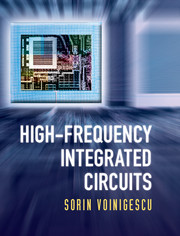Refine search
Actions for selected content:
1808 results in Circuits and systems
10 - Noise figure characterization
- from Part III - Linear measurements
-
-
- Book:
- Modern RF and Microwave Measurement Techniques
- Published online:
- 05 June 2013
- Print publication:
- 20 June 2013, pp 240-278
-
- Chapter
- Export citation
List of abbreviations
-
- Book:
- Modern RF and Microwave Measurement Techniques
- Published online:
- 05 June 2013
- Print publication:
- 20 June 2013, pp xxi-xxvi
-
- Chapter
- Export citation
Contents
-
- Book:
- Modern RF and Microwave Measurement Techniques
- Published online:
- 05 June 2013
- Print publication:
- 20 June 2013, pp vii-xvi
-
- Chapter
- Export citation
Part II - Microwave instrumentation
-
- Book:
- Modern RF and Microwave Measurement Techniques
- Published online:
- 05 June 2013
- Print publication:
- 20 June 2013, pp 39-40
-
- Chapter
- Export citation
1 - Transmission lines and scattering parameters
- from Part I - General concepts
-
-
- Book:
- Modern RF and Microwave Measurement Techniques
- Published online:
- 05 June 2013
- Print publication:
- 20 June 2013, pp 3-20
-
- Chapter
- Export citation

Modern RF and Microwave Measurement Techniques
-
- Published online:
- 05 June 2013
- Print publication:
- 20 June 2013

High-Frequency Integrated Circuits
-
- Published online:
- 05 March 2013
- Print publication:
- 28 February 2013
Contents
-
- Book:
- High-Frequency Integrated Circuits
- Published online:
- 05 March 2013
- Print publication:
- 28 February 2013, pp vii-xii
-
- Chapter
- Export citation
Appendix 5 - Exact noise analysis for a cascode amplifier with inductive degeneration
-
- Book:
- High-Frequency Integrated Circuits
- Published online:
- 05 March 2013
- Print publication:
- 28 February 2013, pp 862-863
-
- Chapter
- Export citation
Appendix 2 - Baseband binary data formats and analysis
-
- Book:
- High-Frequency Integrated Circuits
- Published online:
- 05 March 2013
- Print publication:
- 28 February 2013, pp 852-857
-
- Chapter
- Export citation
Appendix 6 - Noise analysis of the common-emitter amplifier with transformer feedback
-
- Book:
- High-Frequency Integrated Circuits
- Published online:
- 05 March 2013
- Print publication:
- 28 February 2013, pp 864-865
-
- Chapter
- Export citation
5 - Circuit analysis techniques for high-frequency integrated circuits
-
- Book:
- High-Frequency Integrated Circuits
- Published online:
- 05 March 2013
- Print publication:
- 28 February 2013, pp 318-373
-
- Chapter
- Export citation
Appendix 10 - Analytical study of oscillator phase noise
-
- Book:
- High-Frequency Integrated Circuits
- Published online:
- 05 March 2013
- Print publication:
- 28 February 2013, pp 876-889
-
- Chapter
- Export citation
2 - High-frequency and high-data-rate communication systems
-
- Book:
- High-Frequency Integrated Circuits
- Published online:
- 05 March 2013
- Print publication:
- 28 February 2013, pp 14-76
-
- Chapter
- Export citation
6 - Tuned power amplifier design
-
- Book:
- High-Frequency Integrated Circuits
- Published online:
- 05 March 2013
- Print publication:
- 28 February 2013, pp 374-438
-
- Chapter
- Export citation
Index
-
- Book:
- High-Frequency Integrated Circuits
- Published online:
- 05 March 2013
- Print publication:
- 28 February 2013, pp 892-902
-
- Chapter
- Export citation
13 - SoC examples
-
- Book:
- High-Frequency Integrated Circuits
- Published online:
- 05 March 2013
- Print publication:
- 28 February 2013, pp 803-850
-
- Chapter
- Export citation
Preface
-
-
- Book:
- High-Frequency Integrated Circuits
- Published online:
- 05 March 2013
- Print publication:
- 28 February 2013, pp xiii-xviii
-
- Chapter
- Export citation
Appendix 1 - Trigonometric identities
-
- Book:
- High-Frequency Integrated Circuits
- Published online:
- 05 March 2013
- Print publication:
- 28 February 2013, pp 851-851
-
- Chapter
- Export citation
3 - High-frequency linear noisy network analysis
-
- Book:
- High-Frequency Integrated Circuits
- Published online:
- 05 March 2013
- Print publication:
- 28 February 2013, pp 77-141
-
- Chapter
- Export citation
